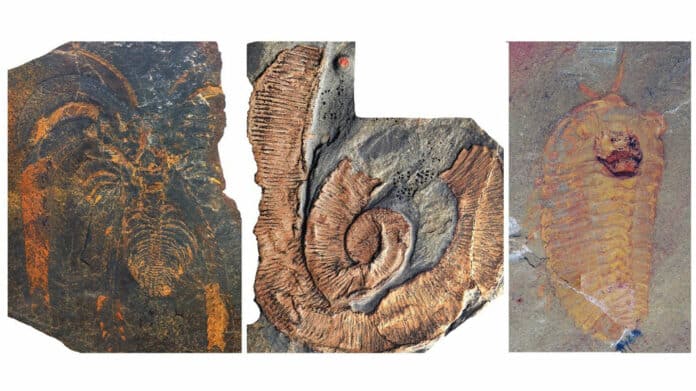The Early Ordovician Fezouata Biota of Morocco is an exceptionally-preserved fossil assemblage that contains a combination of non-mineralized extinct organisms. By pointing to a continuous evolutionary process between the Cambrian Explosion and the Ordovician Radiation, the finding of this biota fundamentally altered our understanding of Earth’s early animal diversifications.
A new study reported the discovery of Taichoute, a new fossil locality from the Fezouata Shale. Numerous huge “free-swimming” arthropods are documented in the earliest evidence from the Taichoute site, which was formerly undersea but is now a desert.
The research done by an international research team, including the University of Exeter, suggests that giant arthropods – relatives of modern creatures including shrimps, insects, and spiders – dominated the seas 470 million years ago.
Scientists noted, “Tarthropods – relatives of modern creatures including shrimps, insects, and spiders – dominated the seas 470 million years ago.”
Lead author Dr. Farid Saleh, from the University of Lausanne and Yunnan University, said, “Everything is new about this locality – its sedimentology, paleontology, and even the preservation of fossils – further highlighting the importance of the Fezouata Biota in completing our understanding of past life on Earth.”
Dr. Xiaoya Ma, from the University of Exeter and Yunnan University, added: “While the giant arthropods we discovered have not yet been fully identified, some may belong to previously described species of the Fezouata Biota, and some will certainly be new species.”
“Nevertheless, their large size and free-swimming lifestyle suggest they played a unique role in these ecosystems.”
Moreover, the study also reports the discovery of the Taichoute fossils. These fossils were preserved in sediments a few million years younger than those from the Zagora area and are dominated by fragments of giant arthropods.
Because of its significance for comprehending the evolution during the Early Ordovician period, some 470 million years ago, the Fezouata Shale was recently chosen as one of the 100 most important geological sites globally.
Some of the fossils in these rocks exhibit excellent preservation of soft tissues, such as internal organs, allowing scientists to study the anatomy of early animal life on Earth. Mineralized materials, such as shells, are among the fossils found in these rocks.
Animals of the Fezouata Shale, in the Zagora region of Morocco, lived in a shallow sea that frequently underwent storm and wave activity. The animal populations were buried as a result, and they are now preserved in situ as remarkable fossils. However, nektonic (or free-swimming) animals remain a minor component of the Fezouata Biota overall.
Dr. Romain Vaucher, from the University of Lausanne, said, “Carcasses were transported to a relatively deep marine environment by underwater landslides, which contrasts with previous discoveries of carcass preservation in shallower settings, which were buried in place by storm deposits.”
Professor Allison Daley, also from the University of Lausanne, added: “Animals such as brachiopods are found attached to some arthropod fragments, indicating that these large carapaces acted as nutrient stores for the seafloor dwelling community once they were dead and lying on the seafloor.”
Dr. Lukáš Laibl, from the Czech Academy of Sciences, who had the opportunity to participate in the initial fieldwork, said: “Taichoute is not only necessary due to the dominance of large nektonic arthropods.”
“Even when it comes to trilobites, new species so far unknown from the Fezouata Biota are found in Taichoute.”
Dr. Bertrand Lefebvre, from the University of Lyon, the senior author of the paper, who has been working on the Fezouata Biota for the past two decades, concluded: “The Fezouata Biota keeps surprising us with new, unexpected discoveries.”
Journal Reference:
- Saleh, F., Vaucher, R., Vidal, M. et al. New fossil assemblages from the Early Ordovician Fezouata Biota. Sci Rep 12, 20773 (2022). DOI: 10.1038/s41598-022-25000-z
